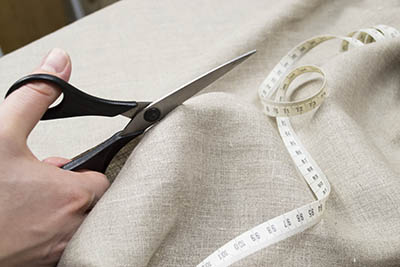
While sewing is one of the fascinating crafting skills that thoroughly examines patience and time to mastering, learning the skill is equally thrilling. The learning process, however, may not be so lucid for beginners even if they feel anxious to absorb the method. The entire sewing and fabrication process merges two methods simultaneously. While, on one side the learning involves the introduction of types of sewing and fabrication styles on the other, they must recognize various types of sewing equipment. So, let’s have an introductory discourse on the learning process of sewing and fabrication, suitable for beginners.
Necessary equipment for sewing
While, the majority of cloths and fabricated crafts are made by machine, yet the affinity of handloom and hand made sewing crafts is soaring up high nowadays. However, before you immerse into the depth of sewing and stitching, acknowledge yourself with the sets of equipment required at times.
1. Sewing needles and plucking rippers
The first and foremost chapter of sewing is to be introduced with types of needles that vary as per cloth material. For instance, while stitching on a satin or silk cloth requires a fine tip needle, it would be blunt headed and coarse size while stitching on rough and thick cloth like denims, sweaters etc. You can buy a whole needle set of Jim Jones that assemble seven different types of needles.
Plucking rippers or seam rippers are needed at the time of plucking out a wrong stitch and getting the thread back.
2. Types of threads
While needles are important to open the chapter of stitching, without proper threads you can proceed. Threads are of different quality, colour and texture. You can choose according to personal need. At the same time it’s important to verify the tenacity of a particular thread before you buy. To ensure it, take a small piece of thread, roll the both ends with fingers and pull out. If the middle of the thread dribbles or sharply seats upon the finger, then it’s the right one.
3. Choice fabric and cloth
Choose the fabric and clothes upon which you will like to weave out your skill later. Choice for these could vary based on personal preference. A piece of fabric and cloth used for DIY home decor crafting significantly varies in quality and texture to sew clothes and apparel. However, you can unfold a massive variety of clothes and fabric at Hobby Lobby, JOAAN, Michales at cost effective price deals.
4. Set of scissors
Since crafting represents great aesthetic value, use of proper sets of scissors are necessary. You must be familiar with the variety of scissors used for a perfect cutting. While a normal scissor is used for a measurement cutting, an embroidered specific scissor is used to curve out perfect shape and design. You can head over to Michales to explore a plethora of embroidery scissors at lofty discounts.
5. Measuring tape
A lot of may wonder after the name, but honestly you can’t initiate the process without a measuring tape in hand. Because, no matter how and where you begin, you must be aware of the measurement of the piece of cloth or fabric.
6. Cutting mate and roller cutters
Both these are of immense importance. As the entire process of sewing involves lots of cutting, you must be accompanied by a cutting board. And roller cutters are used to foil the perfect shape and design. Because, it curtails unnecessary spikes from the cloth pieces and finally brings forth the desired design.
7. Clipping rings
Clipping rings are required to tighten the cloth surface to enable smooth stitching further. The ring comes in a pair of two, where both of these are used exactly in opposite directions placing the piece of clothes in between. Once the cloth portion in between gets tightened, you can start the next step.
**All these equipment can be found at great deals from Hobby Lobby, Michaels at least 50% discount against normal price. You just have to activate the relevant coupons for each of these.
Types of stitching you need to know
After being familiarized with basic machinery and required tools, it’s time to learn a few easy and alluring stitching techniques.
Running stitching
This stitching is the most simplest and used on all garments as well as to flower out simple designs. All you have to do is, take a needle with a medium pointy end and a single pair of thread, then start stitching just by following the up and down knitting process over the cloth. The stitching process goes in a starting line and devoid of complications.
Back stitching
Back stitching is subjective to apt crafting. The knitting process requires lots of forward and backward knitting movements. The idea behind is to generate intertwined threading syntax to adhering beautiful designs at the end. This knitting is quite enduring.
Satin or full coverage stitching
By this method, you will get to learn how to fill the void of a stitched design. You can eventually knit 3D shape design through this sewing. The step is very simple, once you have the stitched cloth in hand, fill each of its void through a simple running sewing. For example, making a leaf inside the outline of it.
Cross stitching
It’s an example of perfect embroidery sewing and generally appears in the advanced stage of learning. The learners will learn to curate designs through weaving of artistic ‘X’ shape throughout the desired portion of clothes. The outcome of these sewing styles becomes breathtakingly beautiful.
Things can be sewing and fabrication process
By this skillful crafting process you can thrash up personal DIY skills immensely. Hence, go through the snippet of what you can design as a neophyte.
Learning button sewing
Although it’s not a pure crafting skill, the skill works as a savior at urgency. Moreover, just to fix a button at the required place, you don’t need to rush to a tailoring shop or get scolded by your mom.
Home decorum cloth piece
Once you get slightly mastered with the process you can shape out tiny yet splendid designs upon cloth or fabric and use it as beautiful home decor items. For example, you can weave types of flowers or calligraphy designs upon a piece of bright color cloth. Then use it as table cloth, TV decoration pieces etc.
Sewing and stitching of apparels
After you become an advanced sewer, you can train yourself for this step if you feel confident. You can even tailor a personal set of clothes. After all, who doesn’t love to wear self made clothes?
The process of learning whether a new subject or mastering a skill has always been enthralling. Hence, fabrication and sewing are not new to these contexts. Hence, if you secretly wish to master at least one stitching style, turn this ‘home framed lockdown’ useful. Begin with a brave and steady mind, you will eventually master even the toughest stitching. Enjoy learning.










